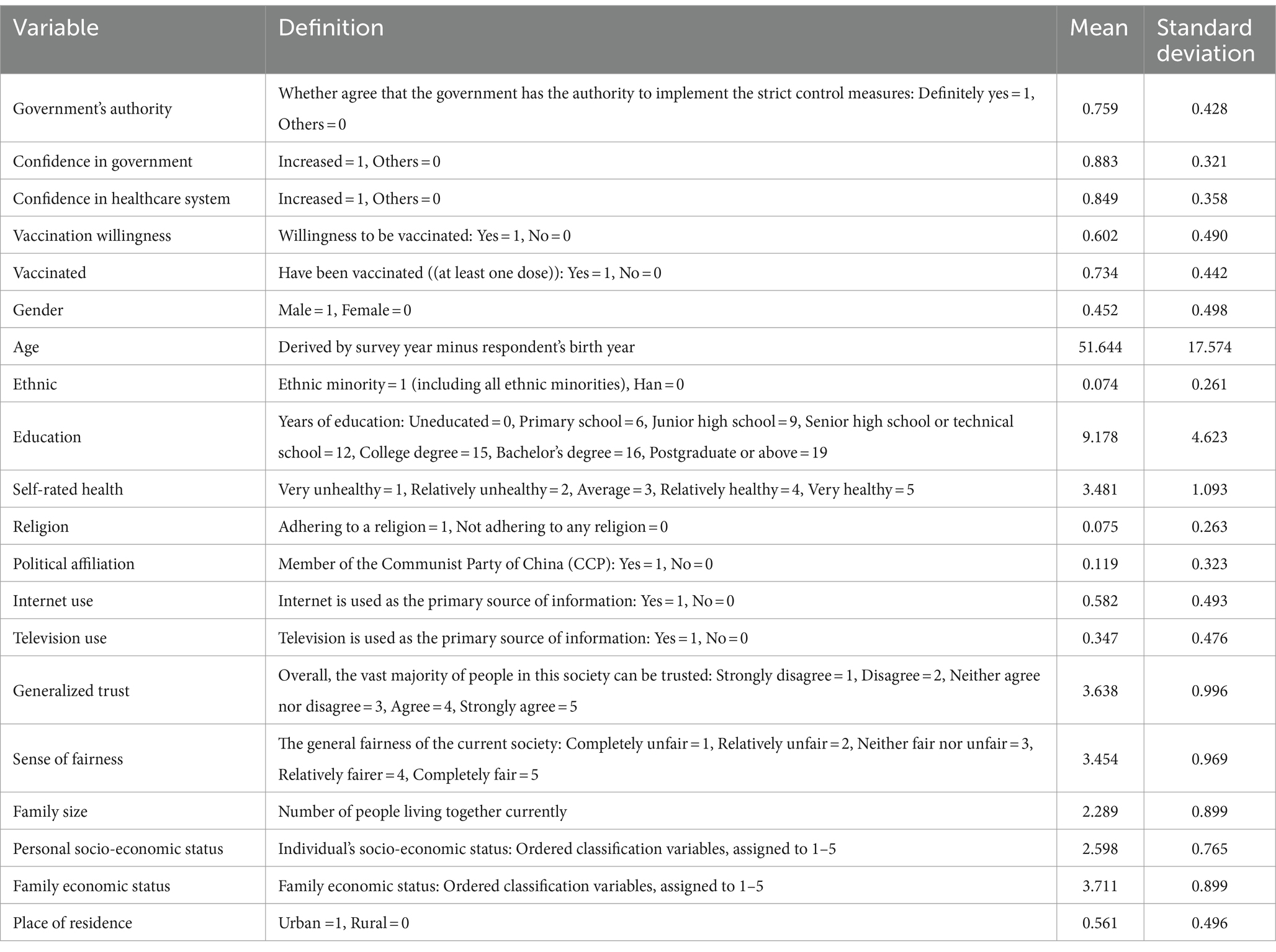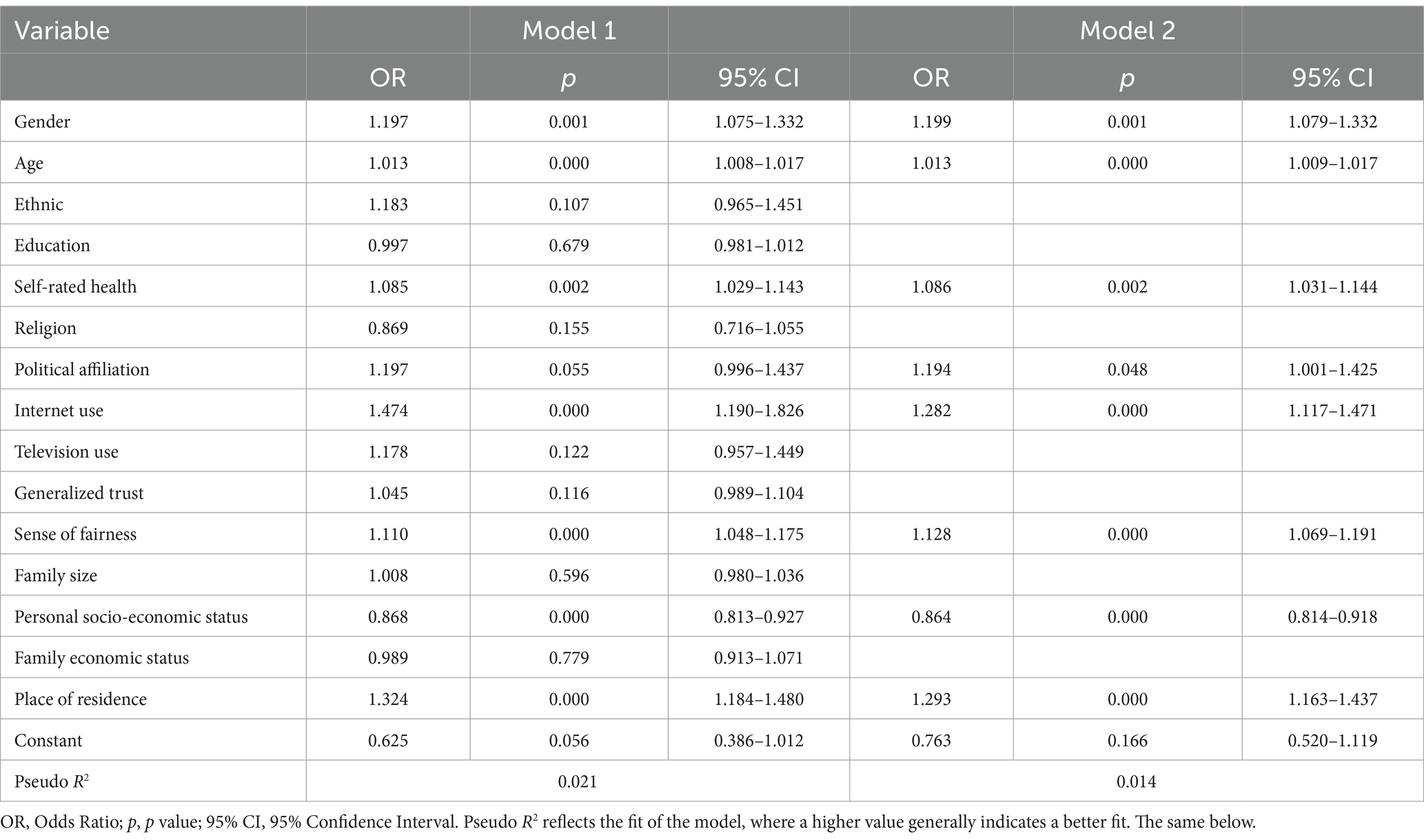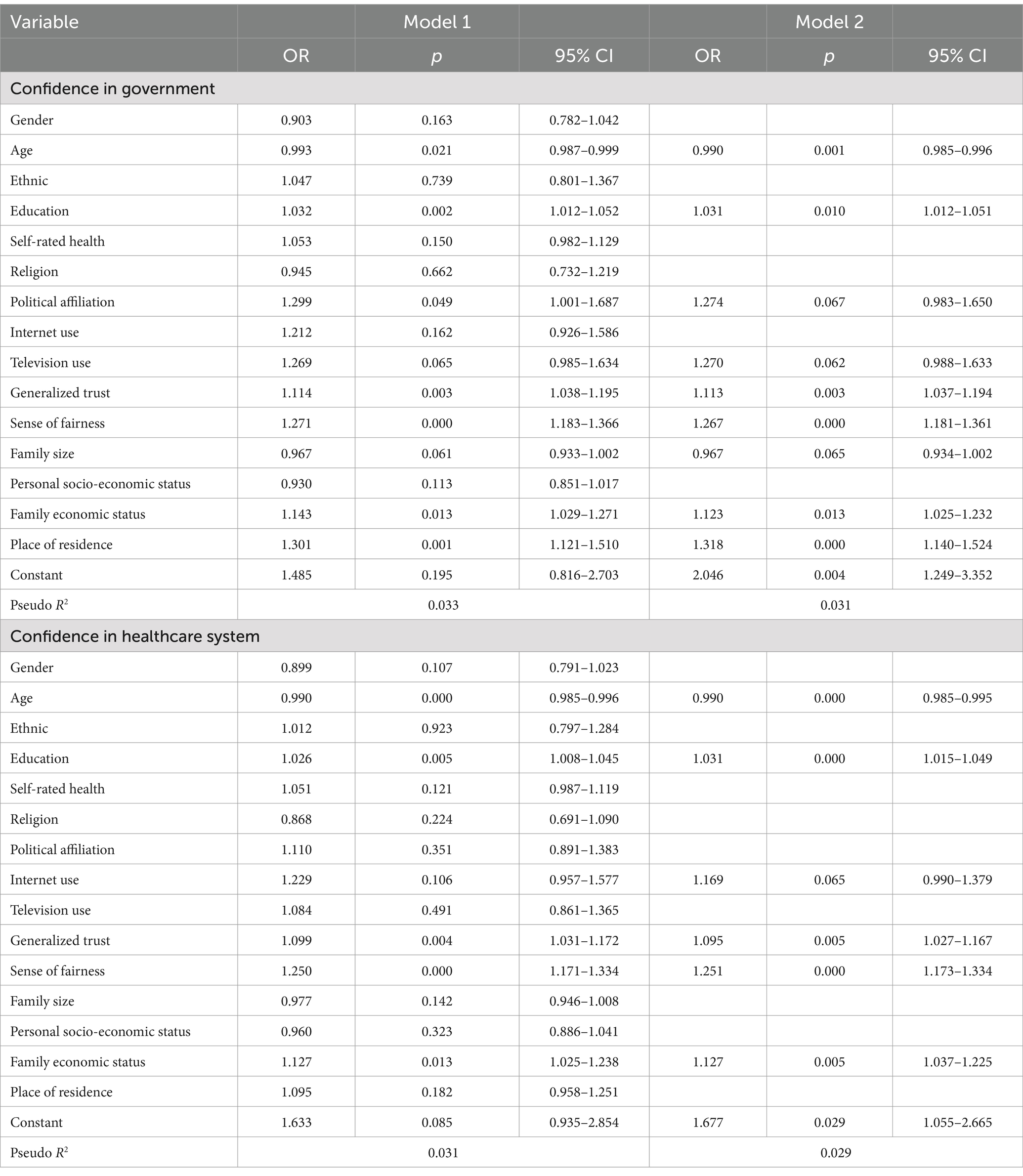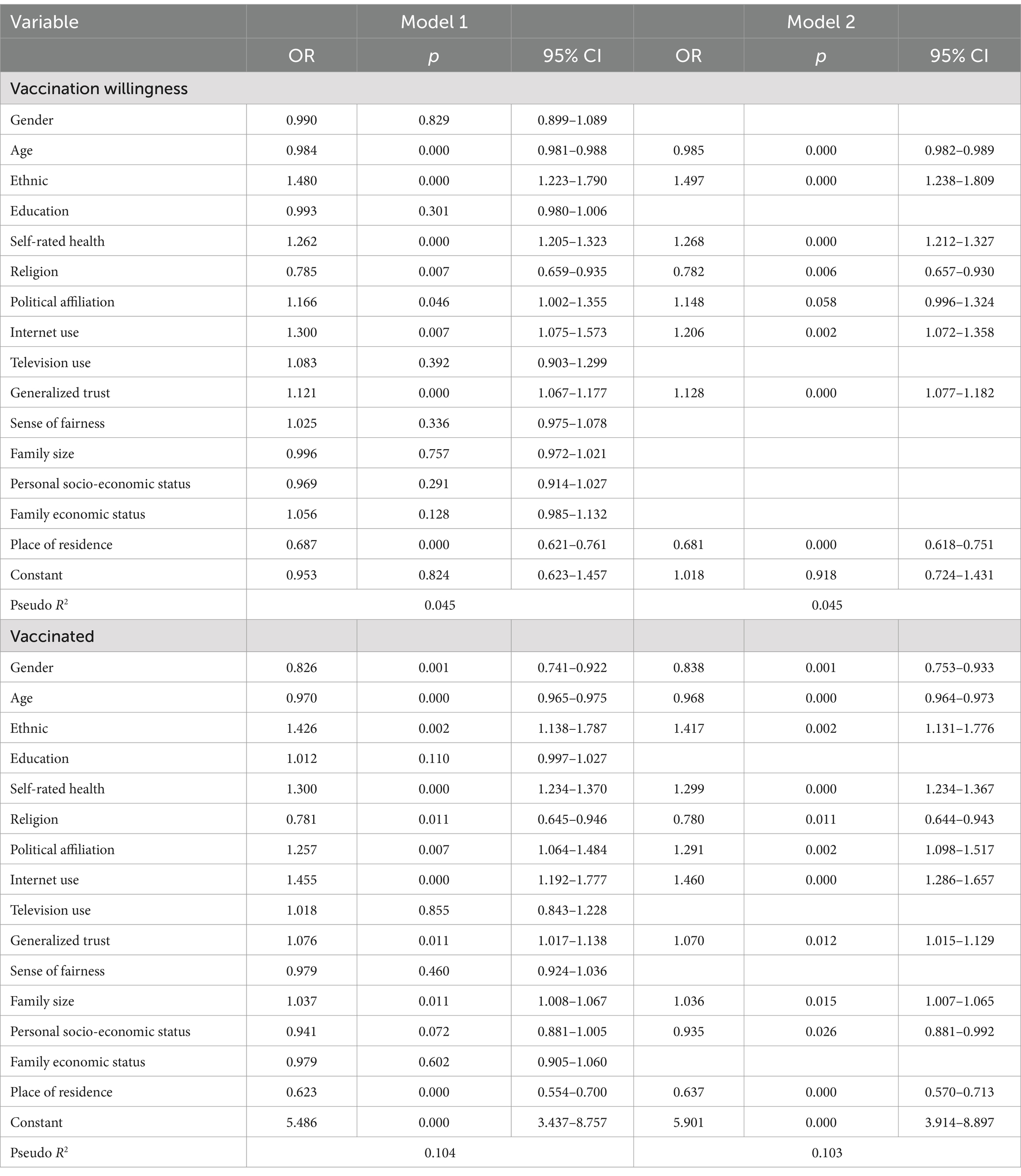- School of Economics and Management, Changzhou Institute of Technology, Changzhou, Jiangsu, China
Based on the data of the Chinese General Social Survey (CGSS) in 2021, this study aims to investigate the public attitudes toward COVID-19 prevention and control in China. The household survey CGSS 2021 contains 8,148 valid samples gathered from 320 communities across 19 provinces in China. The logistic regression model is adopted to examine the relationship between public attitudes and influencing factors. The results show that the vast majority of respondents firmly believe that the government has the authority to implement strict measures; their confidence in the government and in the healthcare system has increased; and they willingly choose to be vaccinated. The regression results suggest that gender, age, health condition, political affiliation, source of information, sense of fairness, socio-economic status, and place of residence are significantly associated with individuals’ attitudes toward COVID-19 prevention and control. These findings highlight the importance for the government to design epidemic or pandemic policies based on data and to tailor them toward specific demographics.
Introduction
Globally, as of 6 September 2023, there have been 770 million confirmed cases of COVID-19, including 6.9 million deaths, reported to WHO (1). China faced huge challenges in controlling the outbreak of COVID-19 pandemic. To minimize the spread of the pandemic, Chinese government implemented a series of strict prevention and control measures (2). These measures lasted nearly 3 years until the government further optimized its control policies in early December 2022. The spread of COVID-19 pandemic has ended in China, but there has been ongoing debate about China’s response strategies and measures (2–7). These strategies and measures were formulated based on a comprehensive consideration of various factors (2, 3), and among them, people’s attitudes are important ones. Lin et al. (8) found that older age, female gender, and lower Human Development Index were independently associated with greater self-reported compliance with COVID-19 public health measures. Cai and Mason (9) argued that the strong support the Chinese government enjoyed in implementing its COVID-19 control measures emerged from people’s self-interest and nationalistic pride. Yuan et al. (10) showed that institutional trust manipulation increased participants’ willingness to complete the COVID-19 test and that interpersonal trust manipulation increased conscious compliance with prevention norms. Jiang et al. (11) found that marital statuses, attitudes toward government measures, and physical condition were significantly correlated with vaccination willingness. Santos et al. (12) found a significant association between influenza uptake and COVID-19 perceptions. Takamatsu et al. (13) found young age, distrust of the Japanese government’s COVID-19 prevention measures, lack of confidence in vaccine efficacy or safety, low reliance on the vaccine, and belief in COVID-19 conspiracy theories were independently associated with booster vaccine hesitancy. Findings in the literature on the public attitudes toward COVID-19 prevention and control are not conclusive. This study analyzes the public attitudes toward COVID-19 prevention and control based on a large amount of survey data in China, in order to offer insights in response to a possible epidemic or pandemic.
Methods
Data source
This study relies on household survey data from the Chinese General Social Survey (CGSS) 2021, conducted by National Survey Research Center, Renmin University of China. Established in 2003, CGSS is the earliest national and continuous academic survey project in China widely utilized by numerous researchers (14, 15). The CGSS employs a stratified three-stage probability proportion to size (PPS) random sample design. The survey of CGSS 2021 was conducted from June 22 to September 30, 2021. It is the latest released CGSS dataset and the first survey of CGSS conducted after the outbreak of COVID-19, and it contains 8,148 valid samples gathered from 320 communities across 19 provinces in China. The questionnaire includes a series of questions about people’s attitudes toward China’s COVID-19 prevention and control.
Variable definition
There are five dependent variables set based on the questions in CGSS 2021’s questionnaire. First, government’s authority is based on the question: “Do you think the government has the authority to implement the following measures during the severe COVID-19 pandemic period: Shut down businesses or workplaces; Require people to stay at home; Monitor and track infected individuals through digital devices; Require people to wear masks; Prohibit public gatherings; Quarantine infected individuals; Temporarily close primary and secondary schools and kindergartens; Close borders.” Government’s authority is coded as 1 for respondents who choose “Definitely yes” for each measure mentioned above, and 0 for others. Second, confidence in government is coded as 1 for respondents who choose “Increased a lot” or “Increased a bit” to the question: “How the government’s anti-COVID-19 measures have changed your confidence in the government,” and 0 for others. Third, confidence in healthcare system is coded as 1 for respondents who choose “Increased a lot” or “Increased a bit” to the question: “How the government’s anti-COVID-19 measures have changed your confidence in the healthcare system,” and 0 for others. Fourth, vaccination willingness is coded as 1 for respondents who choose “I just want to get vaccinated myself” to the question: “Which of the following statements best fits your situation,” and 0 for others. Fifth, vaccinated is coded as 1 for respondents who choose “Yes” to the question: “Have you been vaccinated against COVID-19,” and 0 for respondents who choose “No.”
According to previous studies (8–11), the independent variables include gender, age, ethnic, education, self-rated health, religion, political affiliation, Internet use, television use, generalized trust, sense of fairness, family size, personal socio-economic status, family economic status, and place of residence. Table 1 presents the descriptive statistics of variables.
Model
Since all five dependent variables are binary, the logistic regression model is adopted to investigate the relationship between a series of influencing factors and public attitudes toward COVID-19 prevention and control. The model is shown in Equation (1):
where represents the probability of , and ’s include government’s authority, confidence in government, confidence in healthcare system, vaccination willingness, and vaccinated; is the odds ratio which represents the ratio of the probability of to the probability of ; ’s are various independent variables, including gender, age, ethnic, education, etc. (Table 1); and ’s are estimated coefficients.
Analysis
Government’s authority to implement strict control measures
On average, over 90% of respondents firmly believe that the government has the authority to implement strict measures during the severe COVID-19 pandemic period (Supplementary Table S1).
The regression results for government’s authority are presented in Table 2. Model 1 contains all independent variables, and Model 2 contains only independent variables with a significance level higher than 10% (p < 0.100). The odds ratios indicate that gender, age, self-rated health, political affiliation, internet use, sense of fairness, personal socio-economic status, place of residence are statistically significantly correlated to individuals’ attitudes toward COVID-19 prevention and control. The average difference in the odds ratios of these variables between Model 1 and Model 2 is only 1.77%, indicating that the regression results are robust. Individuals who are male, older, in better health conditions, members of CCP, use Internet as the main source of information, possess a higher level sense of fairness, are at a lower personal socio-economic status, and those who reside in urban areas are significantly more likely to agree that the government has the authority to implement strict control measures.
Changes in confidence due to the control measures
When asked how the government’s anti-COVID-19 measures have changed their confidence in the government and in the health care system, over 60% of respondents indicate that their confidence has increased a lot, and over 20% of respondents indicate that their confidence has increased a bit (Supplementary Table S2; Supplementary Figures S1, S2).
The regression results for confidence in government are presented in the upper part of Table 3. The odds ratios indicate that individuals who are younger, have higher levels of education, are members of CCP, use television as the main source of information, possess a higher level of generalized trust, possess a higher level of sense of fairness, have less family members, are at a higher family economic status, and those who reside in urban areas are significantly more likely to think that the government’s anti-COVID-19 measures have boosted their confidence in the government.
The regression results for confidence in healthcare system are presented in the lower part of Table 3. The odds ratios indicate that individuals who are younger, have higher levels of education, use Internet as the main source of information, possess a higher level of generalized trust, possess a higher level of sense of fairness, and those who are at a higher family economic status are significantly more likely to think that the government’s anti-COVID-19 measures have boosted their confidence in the healthcare system.
Vaccine decision-making
73.42% of respondents report that they have been vaccinated against COVID-19. Among them, 81.95% state that they willingly choose to be vaccinated. The main reasons for being unwilling to get vaccinated are shown in Supplementary Table S3.
The regression results for vaccination willingness (presented in the upper part of Table 4) indicate that individuals who are younger, belong to an ethnic minority, have better health conditions, do not adhere to any religion, are members of CCP, use Internet as the main source of information, possess a higher level of generalized trust, and those who reside in rural areas are significantly more likely to express willingness to get vaccinated.
The regression results for vaccinated (presented in the lower part of Table 4) suggest that individuals who are female, younger, belong to an ethnic minority, have better health conditions, do not adhere to any religion, are members of CCP, use Internet as the main source of information, possess a higher level of generalized trust, have more family members, are at a lower personal socio-economic status, and those who reside in rural areas are significantly more likely to be vaccinated.
Discussion
This study utilizes a dataset from a large-scale household survey, comprising a wide range of Chinese adults who are surveyed about their attitudes toward China’s COVID-19 prevention and control. The results demonstrate that: the vast majority of respondents firmly believe that the government has the authority to implement strict measures during severe COVID-19 pandemic period; their confidence in the government and in the healthcare system has increased; and they willingly choose to be vaccinated. These findings reveal a high level of public compliance with strict anti-COVID-19 measures in China, which is in line with prior research (9, 11). Furthermore, the results suggest that gender, age, health condition, political affiliation, source of information, sense of fairness, socio-economic status, and place of residence are significantly associated with individuals’ attitudes toward China’s COVID-19 prevention and control. On the one hand, sociodemographic characteristics will affect their attitudes toward the government’s policies (9, 11); on the other hand, the effects of pandemic prevention and control measures vary across socioeconomic groups (16). These findings highlight the importance for the government to design epidemic or pandemic policies based on data and to tailor them toward specific demographics (17). Although the majority of the respondents strongly supported the government’s policies against COVID-19 during the first 2 years of the pandemic, people’s attitudes will change when the situation changes or the information they have got changes (9), especially among young people (13). Therefore, the government should pay more attention to the changes in public attitudes, provide clear and trustworthy information (17, 18), send personalized messages (especially targeted and tailored messages for the young generation) (13), and then make policy adjustments in due time.
Conclusion
The findings of this study support previous studies that reveal a high level of public compliance with strict anti-COVID-19 measures in China. Furthermore, it underlines the impact of gender, age, health condition, political affiliation, source of information, sense of fairness, socio-economic status, and place of residence on individuals’ attitudes toward COVID-19 prevention and control. These findings highlight the importance for the government to design epidemic or pandemic policies based on specific demographics data and to make timely policy adjustments in response to changes in people’s attitudes.
Data availability statement
Publicly available datasets were analyzed in this study. This data can be found here: http://www.cnsda.org/index.php.
Author contributions
WZ: Data curation, Formal analysis, Writing – original draft, Writing – review & editing.
Funding
The author(s) declare that no financial support was received for the research, authorship, and/or publication of this article.
Conflict of interest
The author declares that the research was conducted in the absence of any commercial or financial relationships that could be construed as a potential conflict of interest.
Publisher’s note
All claims expressed in this article are solely those of the authors and do not necessarily represent those of their affiliated organizations, or those of the publisher, the editors and the reviewers. Any product that may be evaluated in this article, or claim that may be made by its manufacturer, is not guaranteed or endorsed by the publisher.
Supplementary material
The Supplementary material for this article can be found online at: https://www.frontiersin.org/articles/10.3389/fpubh.2024.1292747/full#supplementary-material
References
1. WHO. (2023). WHO coronavirus (COVID-19) dashboard. Available at: https://data.who.int/dashboards/covid19/data
2. Ding, D, and Zhang, R. China’s COVID-19 control strategy and its impact on the global pandemic. Front Public Health. (2022) 10:857003. doi: 10.3389/fpubh.2022.857003
3. Kupferschmidt, K, and Cohen, J. Can China’s COVID-19 strategy work elsewhere? Science. (2020) 367:1061–2. doi: 10.1126/science.367.6482.1061
4. Cheshmehzangi, A, Zou, T, and Su, Z. Commentary: China’s zero-COVID approach depends on Shanghai’s outbreak control. Front Public Health. (2022) 10:912992. doi: 10.3389/fpubh.2022.912992
5. Cheng, S, Zhao, Y, Kaminga, AC, Zhang, X, and Xu, H. China’s fight against COVID-19: what we have done and what we should do next? Front Public Health. (2022) 10:548056. doi: 10.3389/fpubh.2022.548056
6. Shi, J, Chen, F, Chen, S, and Ling, H. COVID-19 over the last 3 years in China, what we’ve learned. Front Public Health. (2023) 11:1209343. doi: 10.3389/fpubh.2023.1209343
7. Zhu, S, Feng, S, Ning, X, and Zhou, Y. Analysis of China’s fight against COVID-19 from the perspective of policy tools—policy capacity. Front Public Health. (2022) 10:951941. doi: 10.3389/fpubh.2022.951941
8. Lin, T, Harris, EA, Heemskerk, A, Van Bavel, JJ, and Ebner, NC. A multi-national test on self-reported compliance with COVID-19 public health measures: the role of individual age and gender demographics and countries’ developmental status. Soc Sci Med. (2021) 286:114335. doi: 10.1016/j.socscimed.2021.114335
9. Cai, YT, and Mason, KA. Why they willingly complied: ordinary people, the big environment, and the control of COVID-19 in China. Soc Sci Med. (2022) 309:115239. doi: 10.1016/j.socscimed.2022.115239
10. Yuan, H, Long, QY, Huang, GL, Huang, LQ, and Luo, SY. Different roles of interpersonal trust and institutional trust in COVID-19 pandemic control. Soc Sci Med. (2022) 293:114677. doi: 10.1016/j.socscimed.2021.114677
11. Jiang, N, Yang, C, Yu, WJ, Luo, LY, Tan, X, and Yang, LP. Changes of COVID-19 knowledge, attitudes, practices and vaccination willingness among residents in Jinan, China. Front Public Health. (2022) 10:917364. doi: 10.3389/fpubh.2022.917364
12. Santos, A, Kislaya, I, Matias-Dias, C, and Machado, A. Health beliefs and attitudes towards influenza and COVID-19 vaccination in Portugal: a study using mixed method approach. Front. Public Health. (2023) 11:11. doi: 10.3389/fpubh.2023.1331136
13. Takamatsu, A, Honda, H, Miwa, T, Tabuchi, T, Taniguchi, K, Shibuya, K, et al. Factors associated with COVID-19 booster vaccine hesitancy: a nationwide, cross-sectional survey in Japan. Public Health. (2023) 223:72–9. doi: 10.1016/j.puhe.2023.07.022
14. Marois, G, Gietel-Basten, S, and Lutz, W. China’s low fertility may not hinder future prosperity. Proc Natl Acad Sci U S A. (2021) 118:e2108900118. doi: 10.1073/pnas.2108900118
15. Xie, Y, Dong, H, Zhou, X, and Song, X. Trends in social mobility in postrevolution China. Proc Natl Acad Sci USA. (2022) 119:e2117471119. doi: 10.1073/pnas.2117471119
16. Napoli, L, Sekara, V, García-Herranz, M, and Karsai, M. Socioeconomic reorganization of communication and mobility networks in response to external shocks. Proc Natl Acad Sci USA. (2023) 120:e2305285120. doi: 10.1073/pnas.2305285120
17. Cardwell, K, Clyne, B, Broderick, N, Tyner, B, Masukume, G, Larkin, L, et al. Lessons learnt from the COVID-19 pandemic in selected countries to inform strengthening of public health systems: a qualitative study. Public Health. (2023) 225:343–52. doi: 10.1016/j.puhe.2023.10.024
Keywords: COVID-19, vaccination, pandemic, attitude, China
Citation: Zhu W (2024) Public attitudes toward COVID-19 prevention and control in China. Front. Public Health. 12:1292747. doi: 10.3389/fpubh.2024.1292747
Edited by:
Maximilian Pangratius de Courten, Victoria University, AustraliaReviewed by:
Jan Mohammad Mir, Islamic University of Science and Technology, IndiaAssis Kamu, Universiti Malaysia Sabah, Malaysia
Copyright © 2024 Zhu. This is an open-access article distributed under the terms of the Creative Commons Attribution License (CC BY). The use, distribution or reproduction in other forums is permitted, provided the original author(s) and the copyright owner(s) are credited and that the original publication in this journal is cited, in accordance with accepted academic practice. No use, distribution or reproduction is permitted which does not comply with these terms.
*Correspondence: Wei Zhu, emh1d2VpMzY1QDEyNi5jb20=
 Wei Zhu
Wei Zhu


